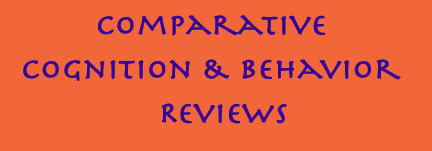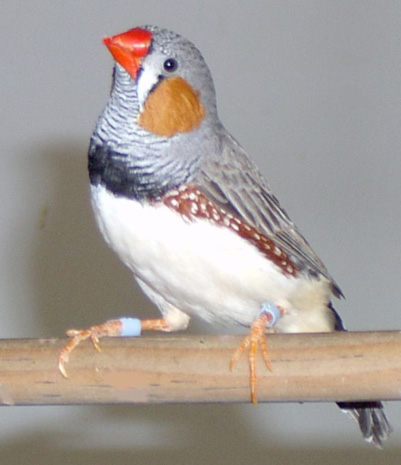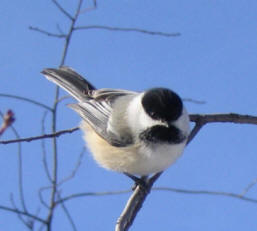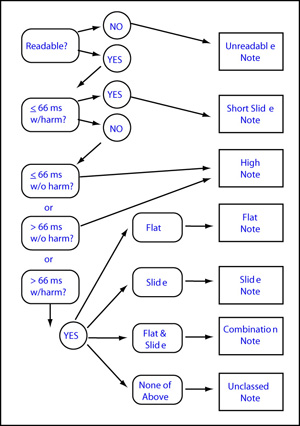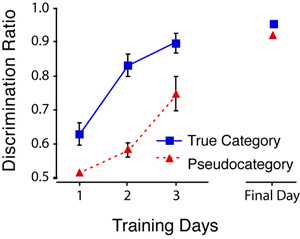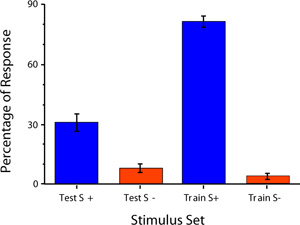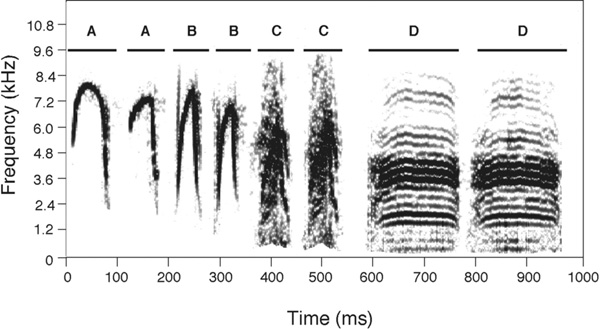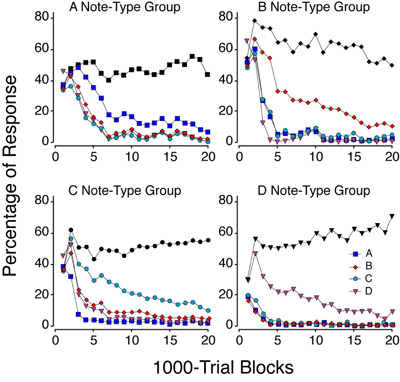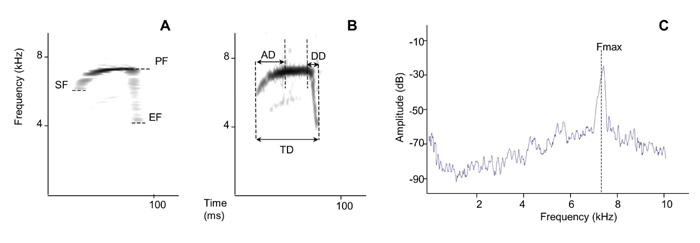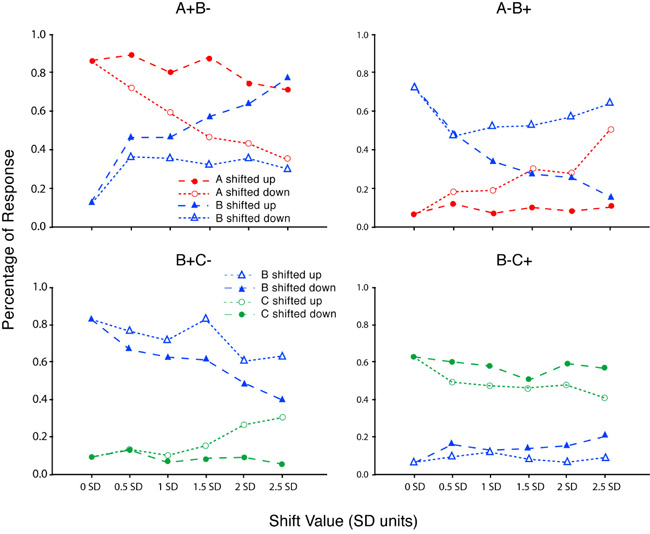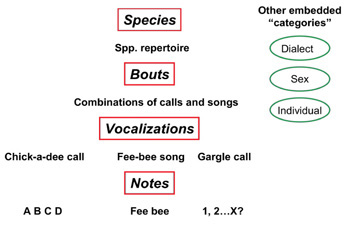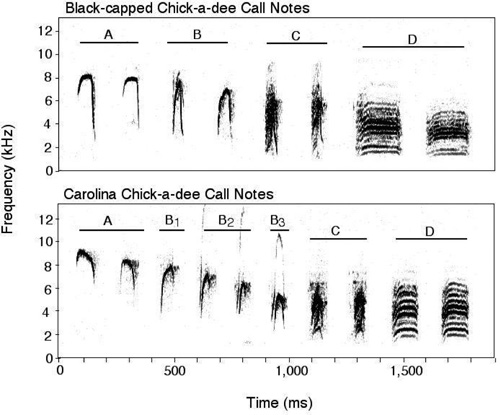| <<Vol. 2 Table of Contents | |
|
|
|
|
2007 |
Volume 2, pp 93-110 |
Auditory Category Perception as a Natural Cognitive Activity in Songbirds
Christopher B. Sturdy, Laurie L. Bloomfield, Tara M. Farrell, and Marc T. Avey
University of Alberta
Ronald G. Weisman
Queen’s University
|
||||||||||||||||||||||||||||||
|
Categorization is the basic process of sorting discriminably different exemplars into classes or categories. Zentall, Galizio, and Critchfield (2002) expanded this to say that categorization is the process of determining what things belong together and a category is a group or class of stimuli or events that so cohere. Most often, similarity is the critical determinant of whether exemplars are placed in the same category. Categorization is both a natural cognitive activity, e.g., when a toddler applies the label ‘dog’ to a novel exemplar, and the result of extensive formal instruction and training, e.g., when a molecular biologist identifies an individual as a member of a particular species and family on the basis of analysis of exemplar DNA. It is difficult to overestimate the power categorization confers. The ability to sort exemplars into categories confers an instantaneous advantage in selecting objects by category (e.g., foods, mates, conspecifics, heterospecifics). Without the ability to sort exemplars into categories, differences between stimuli must be learned one-by-one. The nature of categorization has been the subject of theorizing and research for at least 2,500 years; both Plato and Aristotle speculated about categorization. Some students of human cognition (e.g., Rosch, 1978) view categorization as the essence of cognition. Stevan Harnad (2005) has gone as far as to suggest that ‘cognition is categorization.’ That nonhuman animals are capable of categorization is a relatively new finding in the history of comparative cognitive science (Herrnstein & Loveland, 1964). Herrnstein (see review, 1990) and Wasserman (see review, 1995) have contributed both important experiments and important thinking to the modern view of categorization. The main experimental criteria for categorization are as follows: The exemplars of a category must be discriminable one from another (Astley & Wasserman,1992). The exemplars of different categories must be more easily discriminable than exemplars of the same category (Astley & Wasserman, 1992). Once demonstrated for a limited set of exemplars, any given categorization must transfer effectively across all novel exemplars (e.g., Herrnstein & Loveland, 1964). Finally, the nominal category labels applied to sets of exemplars (e.g., people, flowers, cars, and chairs; Wasserman, Kiedinger, & Bhatt, 1988) must be descriptive of the actual categories a species uses to classify exemplars (see Cook, 2002). Categorization of Vocalizations in Songbirds This article is about how birds of the oscine suborder (the true songbirds) of the order Passeriformes identify their own (conspecific) vocalizations amidst a plethora of other species (heterospecific) vocalizations. We further ask how recognition of the individual notes combines to make recognition of a species’ songs and calls possible. In addition, we consider other more subtle ways in which songbirds categorize vocalizations (e.g., by individual, by sex, and by dominance). Here we show how remarkably well the principles of categorization, described in the previous paragraph, fit the actual categorization of individual notes, songs, song types, and calls. The oscines are an important problem for biology. Oscines are a vast suborder (over 5000 species and still counting) and possess some fascinating attributes. With few exceptions, oscines mate and pair for extended periods, they co-rear their young, and probably most important, they are one of nature’s six experiments in learned vocal communication. Songbirds learn their songs from conspecific tutors, e.g., their father or another nearby male, with no evidence of any explicit reinforcer system (Thorpe, 1951; Marler & Tamura, 1962). Only three groups of birds and three groups of mammals learn their vocalizations. Interestingly enough, the one primate species that does learn their vocalizations from conspecific tutors is the human primate. Songbirds copy most accurately from a tutor during a particular developmental window early in life, and it is now well known that humans also have a sensitive period for acquiring their vocalizations. Not only do songbirds and humans need a tutor, they also require auditory feedback. That is, they must hear themselves practicing to learn and maintain their learned vocalizations. Furthermore, songbird vocal learning, production, and perception are subserved by dedicated systems of brain areas termed the song production (Nottebohm, Stokes, & Leonard, 1976) and perception (Sen, Theuissen, & Doupe, 2001) pathways. These nuclei are not present in non-vocal learning orders of birds, but similar structures are present in other vocal learning orders, such as parrots and hummingbirds. (The discovery of similar brain structures in these other orders came later; Jarvis & Mello, 2000; see also Jarvis et al., 2000.) It is well known that a system of brain centers underlie human speech. Our interest in comparisons between human and songbird vocalizations is based on the analogous functions of human speech and bird songs and calls (i.e., learned intraspecific communication) and does not require homology between speech and song. In addition to the analogy with human speech, songbird vocalizations offer a number of interesting advantages as an object of study. One such advantage is that it now appears that how songbirds categorize conspecific vocalizations is a tractable problem. An important reason the problem is tractable is that digital technology makes it possible to record, modify, and present bird vocalizations at high accuracy and relatively low cost (see Sturdy & Weisman, 2006). Advances in digital technology have made bioacoustics a thriving descriptive science that has provided the methods and the detailed analysis of bird vocalizations that make the present work possible. Thus, we have access to hundreds of songs and calls and the ability to provide detailed bioacoustic descriptions and modifications of these potential category exemplars. A final reason for our efforts is that they attract an audience of ornithologists who would like to know about our findings. Stimulus Generalization and Categorization In a brief statement of prophetic proportions, Keller and Schoenfeld (1950, p. 155) stated that, "Generalization within classes and discrimination between classes—this is the essence of concepts." At a descriptive level, this is a useful narrative of how operant discriminations produce accurate and powerful category learning: differentially reinforce responses to one category of stimuli and extinguish responses to the other categories (e.g., Astley & Wasserman, 1992), or alternatively make responses to each of the categories available simultaneously on each trial and reinforce only responses to the one category of stimuli present on that trial (e.g., Wasserman et al., 1988). We applaud Keller and Schoenfeld’s (1950) elegance and foresight. However, we must also point out that at an explanatory level there are many and serious shortcomings (see also Zentall et al., 2002). One issue is that differential reinforcement (discrimination) is not the glue that holds exemplars of oscines’ vocal categories together. For example, before their operant training chickadees heard and sang chick-a-dee calls often. Without reinforcement, Keller and Schoenfeld’s hypothesis reduces to a perceptual similarity hypothesis. In other words, discrimination and generalization are a method, but not the only method, to produce categorization. A second issue is that discrimination and generalization fail to capture the well-known cohesiveness of exemplars of a category. A third issue is that discrimination and generalization are not mechanisms. At best they are labels for procedures and the results of those procedures. Of course, one might attempt to apply quantitative models of stimulus generalization to describe song categorization. However, the fourth issue is that these models of generalization provide no clue as to which of the vocal stimulus’s numerous perceptual continuum to measure or how to weight the measures in predicting generalization. In summary, generalization within classes and discrimination between classes does not rise to the level of a coherent, testable explanation for vocal categorization. It is to such a coherent and testable set of hypotheses about the categorization of vocalizations that we now turn. Our Hypotheses about Songbirds’ Categorization of Vocal Stimuli In this article, we will consider the application of method and theory from the study of visual category learning in animals to the phenomena of vocal categorization in songbirds. We will consider how the measurement of bird sounds, the bioacoustics of avian vocalizations, describes the important perceptual features of oscine songs and calls. We will then review evidence about how oscines categorize their vocalizations in the operant discrimination laboratory and in the real world. Finally, we will compare the real-world applications of pigeons’ categorizations of visual stimuli and songbirds’ categorizations of auditory stimuli and explore the evolutionary and theoretical implications of those comparisons. Evidence that Song and Call Notes are Open-Ended Categories
Herrnstein (1990) and Wasserman (1995) asked whether pigeons categorized visual stimuli (in photographic slides and video representations of photographs) in operant discrimination experiments. It is important to realize that the experiments and their logic were bold, surprising, and highly effective. To avoid duplication (i.e., presenting both pigeon and songbird research examples), here we present only benchmark studies of acoustic categorization in songbirds. We summarize evidence that songbirds categorize acoustic recordings of vocalizations in laboratory experiments and in experiments conducted in nature. The laboratory experiments use procedures we have described in detail elsewhere (Sturdy & Weisman, 2006, but see Figure 1 for a schematic of our operant chamber). In brief, a bird hears an acoustic stimulus presented via a nearby speaker after landing on a monitored perch. If the stimulus is an S+, then flying or hopping from the perch to a feeder is rewarded with food, if the stimulus is an S-, then hopping to the feeder is not rewarded with food and is punished by a delay before the next trial. This is termed an operant go/no-go discrimination because an animal is trained to respond (go) to S+ and not to respond (no-go) to S-. We have tested category perception in songbird species including zebra finches (Taeniopygia guttata), black-capped chickadees (Poecile atricapillus) and mountain chickadees (P. gambeli). Zebra finches (see Figure 2) are small songbirds native to Australia. Because they breed easily in captivity, zebra finches are ubiquitous in laboratory studies of oscine song production and perception, mate choice based on song, and the neurobiological bases of vocal production and perception in oscines. We also report extensively on research with chickadees, in particular black-capped chickadees (see Figure 3), found in nature throughout temperate (and sometimes in even colder) regions of North America. Chickadees have been studied extensively and much is known about their songs and calls. In common with other oscines, zebra finches and chickadees learn their songs and some of their calls from conspecifics.
Bioacoustics: The Science of Animal Sounds
Bioacoustics is the science of animal sounds, which includes the use of sound for communication. Sound is used for a wide variety of biologically important communications including sexual calls (learned songs in oscines), alarm calls (usually alerts about predators), and aggressive calls (that in oscines include songs). Bioacoustics is placed at the junction of the physics of sound and the biology of communication. Bioacoustics is central to the study of acoustic category perception in songbirds. Bioacoustics and statistics define stimuli for the study of categorization of bird vocalizations. Bioacoustics includes both the scientific measurement of sounds and the scientific manipulation of sounds to alter some features of an animal sound while preserving the remaining features. By song features we mean perceptible quantitative variation in measurable stimulus aspects of vocalizations. It has always been possible, in theory, to record, measure, and abstract the temporal and frequency characteristics of vocalizations. Over the past several decades, the techniques of bioacoustics have progressed so that the features of a species’ songs can be analyzed and reduced to statistical estimates of population values in a few arduous days of study. Research in oscine vocal category perception begins with extensive bioacoustic analysis. For example, we began our study of zebra finches’ categorization of conspecific song notes with a bioacoustic analysis of the five most commonly heard notes in zebra finch songs (see Figure 4). The sound spectrograms in Figure 4 require some explanation. Spectrograms are obtained by a process analogous to passing a filter through the sound repeatedly set at successively higher frequencies to measure the energy present across the acoustic spectrum. The darker the pixels in the spectrogram, the higher the energy at those frequencies and at those temporal locations in the sound file. Consider the short slide and slide notes shown in panels A and B, respectively, in Figure 4. Both notes fall (slide downwards) in frequency over time and show multiple harmonics over a wide range of frequencies. Harmonics refer to bands of energy at integer multiples of the fundamental frequency in the sound. Short slide notes are both shorter in duration and weaker in energy than slide notes. The very dark band of energy in the slide notes (see panel B) illustrates the frequencies of the loudest harmonics in the signals. Sturdy, Phillmore, and Weisman (1999) developed a bioacoustic strategy (see Figure 5) that classified over 90% of our sample of song notes into the five most common zebra finch song note types, with inter-observer agreement of 94%. How Oscines Categorize Their Vocalizations: An Example From the Laboratory We begin our description of experimental work with a report of song-note categorization in zebra finches. In experiments testing song-note categorization in zebra finches, Sturdy, Phillmore, Price, and Weisman (1999; see also Braaten, 2000) presented true-category discrimination to one group of zebra finches and pseudocategory discrimination to a second group of zebra finches. Birds in the true-category discrimination were trained in four subgroups. In each subgroup, 20 exemplars of a different zebra finch song note type served as S+ notes (short slide, slide, flat, or combination; see the spectrograms in Figure 4) and 20 exemplars of each of the other three note types served as S- notes. The pseudocategory group also consisted of four subgroups. Each subgroup discriminated 20 S+ exemplar notes from 60 S- exemplar notes, but with this important difference: S+ and S- notes were chosen at random with respect to note type separately for each subgroup. Results shown as the discrimination ratios (percentages of response to S+ notes/ percentages of response to S+ and S- notes) in Figure 6, illustrate two benchmark principles of categorization. Zebra finches discriminated a true (consistent) category of exemplar notes more rapidly than a random assortment of notes from all four categories, and zebra finches were able to memorize an assortment of 20 song notes, note-by-note in the pseudocategory group, but they did so more slowly than in the true-category group. The pseudocategory control group was developed (see Herrnstein & de Villiers, 1980) to provide a simple direct comparison for pigeons trained with a consistent relationship between exemplars of a category and reward (the true-category condition). A third benchmark principle of categorization is demonstrated when a category discrimination learned with a limited set of trained exemplars transfers to novel exemplars. Sturdy, Phillmore, Price, et al. (1999) tested zebra finches in the true-category discrimination group with novel exemplars, and the birds responded more to novel S+ exemplars than to novel S- exemplars (see Figure 7). That responding to these exemplars was not mediated by a failure to discriminate novel from previously trained notes is shown by reduced responding to novel notes compared to the training notes (see Figure 7). In other words, zebra finches showed that they discriminated novel test notes from the original training notes by responding less to the test notes.
How Oscines Categorize Their Vocalizations: An Example From the Field Songbirds use their songs and calls for many functional, biologically important, tasks. The functional distinction between songs and calls is that songs are used mainly by males in territorial interactions with other breeding males and to attract a female to form a breeding pair, whereas calls are used in non-breeding social contexts and to warn conspecifics about predators. It is well known that in the field, territorial males respond aggressively to the songs of conspecific male strangers, much less aggressively to the songs of familiar conspecific neighbors (whose songs they hear often and with whom territorial boundaries are settled), and again less aggressively to the songs of heterospecific males, with whom they are not in competition for mates or mating territories. In an elegant field experiment, Nelson (1989a) demonstrated that songbirds (i.e., field sparrows) simultaneously categorize familiar and unfamiliar conspecifics (territorial neighbors and strangers) and hetrospecifics on the basis of song alone. Nelson played the recorded songs of territorial neighbors to individual field sparrows on their territories and recorded their aggressive territorial defense responses (e.g., singing and flying to the speaker) as a function of altering the song’s spectral frequency. Songs played at the neighbors’ pitch engendered little response but songs played at lower pitches engendered much increased aggression. Further decreases in pitch rendered the response to song indistinguishable from the response to a heterospecific, and otherwise quite acoustically distinct, black-capped chickadee song. Nelson (1989a) was able to compress a summary of our laboratory categorization experiments into five trials presented over a 50-70 minute interval in a single morning. Clearly, one can accomplish much in the laboratory
and gain more control over the stimuli and obtain repeated measures
unavailable in the field. And yet, it is field research that
demonstrates songbirds are using the power of acoustic categorization to
identify conspecifics; therefore, fieldwork renders the laboratory
research biologically important. The fieldwork demonstrates, without
speculation or excuse, that one is studying the process whereby
songbirds recognize conspecific vocalizations. Additionally, the
biological importance of songs and calls insures that over millions of
years evolution has shaped oscine vocalizations to oscine perception and
oscine perception to oscine vocalizations. Hence, oscines’
categorizations of songs and calls have an evolutionary centrality
simply absent from pigeons’ categorizations of photos of flowers and
chairs. Understanding the Relationship Between Oscine Note Production and Perception: An Extended Example From Black-Capped Chickadee Calls One of the best-studied and most complex oscine calls is the black-capped chickadee’s ‘chick-a-dee’ call (see Figure 8 for a spectrogram of the note types), which is used to raise mild alarm and coordinate flock activities (Hailman, Ficken, & Ficken, 1985). Also, particular calls and note types within the chick-a-dee call convey specific information. For example, black-capped chickadees are capable of discriminating between their own and another flock’s chick-a-dee calls using information in the D-type call note (Nowicki, 1989). Chickadees sing their four call note types in a fixed order (A àBàCàD) but note types can be repeated or omitted to produce chick-a-dee calls composed of virtually unlimited combinations of notes (e.g., ACCCD, ABDDD). The combinatorial nature of the chick-a-dee call shares many features with human speech (Hailman et al., 1985). In common with speech, the chick-a-dee call is learned (Hughes, Nowicki, & Lohr, 1998), the numbers of notes and note types in different renditions of the call change with context, and new combinations of notes (compositions) are common (Smith, 1972; Freeberg & Lucas, 2002).
Chick-a-dee note types are open-ended categories
Black-capped chickadees, and the chick-a-dee call for which they are named, have been very well studied (e.g., Hailman & Ficken, 1996). Early on, Ficken, Ficken, and Witkin (1978) provided the bioacoustic analysis, still important today, that described the call and delimited the four call note types termed in both temporal and alphanumeric order, A, B, C, and D (see Figure 8). Nowicki and Nelson (1990) used the chick-a-dee call in their comparison of the different methods bioacousticians apply to classify natural signals into types. In their article, Nowicki and Nelson observed that an important, but then unrealized, step in the analysis was to determine whether the birds themselves sorted call notes into the same note types as bioacousticians. Sturdy, Phillmore, and Weisman (2000) conducted just such a study. Sturdy et al. (2000) asked whether black-capped chickadees sorted their call notes in the same way as bioacousticians. We used a similar operant between-category discrimination task as in note discriminations by zebra finches but in contrasts between A, B, C, and D chick-a-dee call notes, and we added a simultaneous within-category task. For example, the A+ group discriminated 15 A notes as S+s from 15 A notes as S-s (the within-category task), and 15 notes each from the B, C, and D note categories as S-s (the between-category task). The B+, C+, and D+ groups had analogous training. If chickadees sorted the notes into true, natural categories based on greater acoustic perceptual similarity among notes within a category than across notes between categories, chickadees should be able to perform both discriminations (i.e., be able to discriminate both within and between call note categories) but they should learn the between-category discrimination faster than the within-category discrimination. This was exactly what we found (see Figure 9). The within-category vs. between-category discrimination comparison was developed by Astley and Wasserman (1992) to demonstrate that pigeons can discriminate among individual exemplars of a visual category but do so more slowly than between categories of exemplars. Sturdy et al.’s (2000) main conclusions were that chickadees can discriminate among exemplar notes within a note category and that chickadees’ errors in sorting notes in a true-categories reflect the similarities among notes described in bioacoustical analyses (e.g., Nowicki & Nelson, 1990).
Further evidence of categorization comes from the second and third phases of Sturdy et al.’s (2000) experiment. In the second phase, we replaced the unreinforced between-category notes with novel and now reinforced notes from the same categories and observed good transfer of inhibition. These novel notes were reinforced at 100% and, in spite of this, the birds showed significant inhibition of response to the notes. In fact, inhibition was so profound that only a subset of birds ever came to respond to the previously negative note types (see Figure 10). Those birds that did slowly reverse (moving from low to high percentages of response) during the second phase provided an important test for strong categorization (conceptualization) suggested by Lea (1984) and Herrnstein (1990). This third and final test of categorization involved brief reintroduction of previously discriminated unreinforced, S-, between-category call notes (used during the first phase of the experiment) to chickadees that had reversed their responding during phase two (reinforced reversal training with novel calls). If birds were memorizing and not categorizing notes by type, one would predict that the birds would fail to respond to previously unreinforced notes. If, on the other hand, chickadees were simply assigning a new valence to the note-type categories after each subsequent (unreinforced, then reinforced) training phase, one would predict that reinforcement would propagate from novel reinforced notes back to the previously unreinforced notes. The latter is exactly what happened – chickadees responded to previously unreinforced notes at levels that were not significantly different than those seen to the same note types at the end of the second phase of training. The results confirm Herrnstein’s (1990) prediction that the reversal in the category-reward relationship in open-ended categorization could propagate back to exemplars not present during the reversal. Mechanisms of call-note perception One advantage of studying animal communication signals is that their bioacoustic analyses are publishable research (e.g., Charrier, Bloomfield, & Sturdy, 2004). A second and more important advantage is that bioacoustic analyses can be used to define functional perceptual features of animal vocalizations for later testing in laboratory or field research. Here we present bioacoustic analyses of the acoustic features of chick-a-dee call notes, and we show estimates of the potential signal value of these call-note features to conspecifics. Charrier et al. (2004) measured quantitative differences in bioacoustic features among the four chick-a-dee call-note types. Chickadee calls were recorded from several black-capped chickadees in the laboratory under controlled acoustic conditions. Bioacoustic measures were collected on each note from each chickadee; included were measures of spectral frequency (F), duration (D), and frequency modulation (FM) across each note. These bioacoustic measures require some explanation. In Figure 11, the sound spectrogram (panel A) shows measurement of highest frequency at the start (SF), peak (PF), and end (EF) of each note. Panel B shows measurement of the total duration (TD), ascending duration (AD), and descending duration (DD) of a note. Frequency and temporal values are taken directly from the spectrogram of each note. The power spectrum (panel C in Figure 11) illustrates the measurement of spectral frequency (F) of a signal, e.g., the loudest frequency, and displays this as a function of its relative amplitude to the rest of the signals. A power spectrum is analogous to a vertical section of the sound spectrogram. Frequency modulation (FM or frequency change within a note) was measured separately during the ascending and descending portion of each note as the rate of change in Hertz per millisecond. FM during the ascending portion of a note, ascFM, was calculated by dividing the frequency change between the start and peak of each note by AD. FM during the descending portion, descFM, was calculated by dividing the frequency change between the peak and end of each note by DD.
Charrier et al. (2004) used these measurements to estimate the potential for note-type coding (PNTC) available for each acoustic measure. The PNTC of a feature is a function of its statistical variability between individuals (Falls, 1982). Nowicki and Nelson’s (1990) research also suggested that note-type coding is statistical; that is, some overlap occurs between temporally adjacent note types. Our hypothesis is that birds code for acoustic features that are more variable between note types than within note types (Charrier et al., 2004). Specifically, the ratio of the mean square variance between notes divided by the mean square variance within notes provides a ratio measure of PNTC. Features with ratios > 1 have useful PNTC. Charrier et al.’s results suggested that two duration measures, TD and AD, two frequency measures, SF and EF, and one frequency modulation measure, ascFM, had potential for note-type coding. Charrier, Lee, Bloomfield, and Sturdy (2005) used the go/no-go operant discrimination methods already described to test the PNTC for three of the useful features for note-type coding obtained from Charrier et al.’s (2004) bioacoustic analysis of chickadee note types. Preliminary to testing, Charrier et al. (2005) trained black-capped chickadees in discriminations between A and B notes or between B and C notes. They used four training procedures, A+ vs. B-, A- vs. B+, B+ vs. C-, and B- vs. C+, with each procedure used for a separate group of chickadees. After training to discrimination ratios (DRs) > .8 with 10 exemplars of each note type, each bird had training with a second set of 10 exemplars of each note type to demonstrate transfer to novel notes. DRs dropped significantly (by an average of .05) in the first block of transfer testing, showing that the birds both generalized their categorization to the novel notes and recognized that the notes were not identical to the first set. Testing for note-type coding by features followed transfer. In these tests, to avoid disturbing the discrimination, only small numbers of altered (test) notes were interspersed among previously trained notes. Test notes were altered systematically in frequency or altered (cut) by including only the ascending or descending portion of the note. Frequency altered test notes were increased or decreased in spectral frequency in statistically ordered steps of 0.5, 1.0, 1.5, 2.0, and 2.5 SDs, with the SDs obtained from the mean frequency in natural call notes, to produce 10 test notes (5 notes of increased frequency and 5 notes of decreased frequency relative to the mean). In addition to the frequency modulated test notes, 2 "cut" notes were interspersed during test sessions. These cut notes included either only the ascFM or only the descFM portion of the note. To reduce confounding due to altering the notes of particular birds, Charrier et al. (2005) presented altered notes from at least two birds for each test note manipulation. Figure 12 summarizes the effects of frequency shifting chickadee call notes. The top panels show results for discriminations between A and B notes. Increasing the frequency of A notes reduced their acoustic similarity to B notes and had only weak effects on the discrimination whether A notes are S+s or S-s. In contrast, decreasing the frequency of A notes increased their acoustic similarity to B notes and produced an orderly reduction of the discriminability of A notes (shown as a decrease in responding to A+ notes and an increase in responding to A- notes). The effect of frequency shifting B notes is just the opposite: Increasing the frequency of B notes increases their acoustic similarity to A notes and produces an orderly reduction in the discriminability of B notes (shown as an increase in responding to B- notes and a decrease in responding to B+ notes). In contrast, decreasing the frequency of B notes decreased their similarity to A notes and had only weak effects on responding to B notes, whether the B notes were S+s or S-s. The bottom panels of Figure 12 show results for discriminations between B and C notes. As with the contrast between A and B notes, decreasing the frequency of B notes and increasing the frequency of C notes render them less discriminable, whereas increasing the frequency of B notes and decreasing the frequency of C notes have only weak effects on discrimination. In summary, shifting note frequency has powerful effects on note-type discriminability when it renders the notes more similar acoustically but not when it renders them less similar.
The effect of cutting notes to present only the ascending or the descending FM portion of a note needs some explanation, because the effect is not due to what is presented but rather to what is omitted. Omitting the ascFM portion of the note (the descFM notes) reduces the discriminability of A and B, and B and C notes more than omitting the descFM portion of the same notes (the acsFM notes). The effect is moderate but reliable, between 10% and 20% changes in responding to the effected notes. Charrier et al.’s (2005) discrimination results follow in an orderly way from Charrier et al.’s (2004) bioacoustic results. Communication signals and their perception have evolved together so that variability in the signals helps predict the relative importance of acoustic features in note-type perception. Notice that Charrier et al. (2005) did not find that all features of a note were important or that the same feature was important in all discriminations: e.g., making notes more similar in frequency had much stronger effects than making them less similar, and omitting the ascending FM portions of notes had stronger effects than omitting the descending FM portions. These results remind us that natural categories are polymorphic, that is, they depend on multiple features of the stimulus. More importantly, the results remind us why the science is called bioacoustics and not simply acoustics: Oscine vocalization stimuli and their perception are not the products of machines (invented by humans to produce fidelity to the stimulus) but are instead a product of animals’ brains (invented by biological evolution for use in rapid processing of signals in mating and other important social contexts). Hierarchies of Acoustic Categories in Songbird Communication
So far we have described research on how songbirds, in particular, chickadees, produce and categorize song and call notes. Here we advance the hypothesis that the categorization of oscine vocalizations is hierarchical (see Figure 13; see also Braaten’s (2000) research on hierarchies in the perception of zebra finch song), with individual notes as the basic units and organized sequences of notes (i.e., songs and calls) as a higher level of categorization. Bouts of songs and calls are at a higher level still. Songs and calls are categorized by the presence or absence of specific notes. The speed of production and the balance of songs and calls included in the bout categorize bouts. Notes and complete sequences of notes identify the species of the singer, and the song or the call being produced can identify the singer by location, dialect, sex, individual, position in the dominance hierarchy, motivation, and message (sexual, aggressive, warning or alert). If these levels of categorization of vocalizations and their meanings impress you as elaborate and complex, your impression is correct. Songs and calls can be acoustically complex, and the referents they symbolize can be complex as well, e.g., a male, conspecific, a mate, high in social status, and involved in territorial defense. Here we present a laboratory example of oscines categorizing whole complex calls by the species of the singer. In direct application of categorization to whole vocalizations, Bloomfield, Sturdy, Phillmore, and Weisman (2003) trained black-capped chickadees with exemplars of whole black-capped and Carolina (P. carolinensis) chickadee calls. Carolina chickadees live in the warmer southern parts of the United States, whereas, as already noted, black-capped chickadees live in more temperate regions of North America. Bloomfield et al. (2003) presented 45 chick-a-dee calls to black-capped chickadees in the go/no-go operant discrimination already described: 15 black-capped chick-a-dee calls were S+s, 15 additional black-capped chick-a-dee calls were S-s (in a within-category discrimination), and 15 Carolina chick-a-dee calls were S-s (in a between-category discrimination). Also, Bloomfield et al. conducted the discrimination with 15 Carolina chick-a-dee calls as S+s, 15 additional Carolina chick-a-dee calls as S-s (in a within-category discrimination), and 15 black-capped chick-a-dee calls as S-s (in a between-category discrimination). Spectrograms of black-capped and Carolina chick-a-dee call notes are shown in Figure 14 upper and lower panel, respectively.
As shown in Figure 15, the between-category call discrimination was acquired faster and more accurately than the within-call category discrimination. The results illustrate two benchmark principles of categorization that apply to species-level call discriminations: Black-capped chickadees use the more rapid categorization process to discriminate between species calls, and they discriminate among calls within a species (categories) by memorizing the calls one-by-one.
Evidence for hierarchical organization of the categorization of oscine vocalizations is also available in the field. Although most studies of species recognition in oscines test song perception, Charrier and Sturdy (2005) conducted field studies of the coding of species information in black-capped chick-a-dee calls. The birds were tested in winter flocks and a unique aspect of the research was that the vocal responses (mainly chick-a-dee calls) of whole flocks of chickadees in response to call playback were tallied. Over a period of a few weeks, flocks were tested with heterospecific calls of a gray-crowned rosy finch (Leucosticte tephrocotis), and chick-a-dee calls of altered frequency, syntax (played backwards or with notes played backwards), and rhythmicity (shortened or lengthened internote intervals). Relative to conspecific calls, heterospecific calls reduced flock calls to baseline levels. Similar strong reductions in calling relative to unaltered calls were observed by reducing the pitch of the test call. Increasing the pitch had much less effect, and slowing the rhythm of calls had more effect than speeding the rhythm. In summary, black-capped chickadees sort conspecific from heterospecific calls. Chick-a-dee calls are polymorphic acoustic stimuli, and the recognition of conspecific calls depends on a multiplicity of pitch and timing cues. We anticipate testing chickadees with the calls of closely related species. Black-capped chickadees and mountain chickadees share overlapping territories in some parts of Alberta, so contrasts between their calls will be of particular interest in observing the hierarchical nature of vocal categorization in oscines. We move now from the top of the categorization hierarchy to the lowest level, individual recognition. Charrier et al. (2004) examined the potential for individual coding (PIC) in black-capped chick-a-dee calls. PIC is the ratio of mean variance between birds to mean variance within birds in the production of note-type features and, in common with PNTC, potential increases with the ratio. PIC was greatest for three features of C notes: PF, Fmax, and ascFM and for all features of D notes. These findings suggest some interesting disassociations between individual and note-type coding (discussed earlier). As yet, no tests of predictions from PIC to black-capped chickadees’ categorizations have been reported. However, Phillmore, Sturdy, Turyk, and Weisman (2002) have shown that black-capped chickadees can use features of their fee-bee song to identify individual conspecifics. Songs and calls can signal sexual, as well as individual, identity. In most oscine species, males produce song and females do not. Because song is most often a species’ most complex vocalization and usually restricted to males, the study of female vocalizations has been limited to a few simple vocalizations. For example, Gray, Bloomfield, and Sturdy (personal communication) have found sex-specific vocal characteristics in the ubiquitous but simple tseet call of black-capped and mountain chickadees. As we have noted previously, both males and females produce chick-a-dee calls. Freeberg, Lucas, and Clucas (2003) have reported that Carolina chick-a-dee calls are sexually dimorphic. In summary, songs and calls include a hierarchy of categorical knowledge about species, territory location, motivation, gender, and individual identity. Categorizing Auditory and Visual Stimuli: A Comparison It is possible to ask whether our studies of auditory categorization in songbirds add anything new to the understanding of categorization in animals. Perhaps, Herrnstein (1990) and Wasserman’s (1995) landmark research, supplemented perhaps by Lea and Harrison (1978), and Cook’s (1992) work on visual categorization in pigeons, provide all the evidence needed to show how and what birds learn about categorizing stimuli? In this section, we acknowledge our debt to these category researchers, particularly Herrnstein and Wasserman and their colleagues, and then discuss serious limitations present in research on visual categorization in pigeons. In our research, we have borrowed freely and with much success from the research methods Herrnstein (1990) and Wasserman (1995) developed for the study of visual categorization in pigeons. For example, Astley and Wasserman (1992) compared between-category and within-category discriminations among photographs of people, flowers, cars, and chairs. They reported that pigeons learned between visual category discriminations faster than within-category discriminations. We used very similar procedures to show that chickadees learn auditory discriminations between call and call note categories (e.g., Carolina vs. black-capped chickadee calls) faster than discrimination within either category (e.g., either among Carolina or black-capped chickadee calls). In particular, Wasserman’s procedures have never failed us. They have always helped us demonstrate that songbird vocalizations are open-ended categories of considerable classificatory power. An important distinction must be made between our experiments with recorded songbird vocalizations and research with photographs presented as slides and on computer screens. This latter (vision) research is circumscribed in applicability to the pigeons’ world outside the laboratory. "Anatomical, physiological, and behavioral investigations indicate that color, depth, flicker, and movement aspects of pigeons’ vision are probably sufficiently different from humans for photographic images to appear quite different from reality" (Delius, Emmerton, Horster, Jager, & Ostheim, 1999; see also Lea & Dittrich, 1999, who draw similar conclusions). It is not a surprise that photographic and video equipment and supplies are designed for the human visual system; people buy these items in vast quantities. Redesigning photography for avian visual systems would be very expensive: the development costs could be in the millions of dollars. This is because differences between the human and avian visual systems are extensive. Humans see three colors while pigeons use a four + color system. Also, the boundaries of pigeons’ colors differ from those of humans (see Wright, 1978), and it is important to know that birds, including pigeons, see into the near ultraviolet (UV: Palacios & Varela, 1992; Wright, 1972). The flicker fusion point in humans is lower than in pigeons (Hendricks, 1966). Cues for three-dimensional objects differ between humans and birds (Spetch & Friedman, 2006). And finally, humans have one visual area of high magnification whereas pigeons have two separate regions of high magnification, the projection areas of the fovea and the middle of the red area in the retina; and the latter area is active in binocular vision (Clarke & Whitteridge, 1976; Conley & Fite, 1980). These differences mean that a pigeon’s eye view of stimuli on a CRT screen, for example, is likely to be of a slowly rolling and repeating, muted and oddly colored, ‘smudged’ image, perhaps at the wrong focal distance. Using projected photographic slides only eliminates the problem of flicker: the other problems remain. Eaton (2005) recently uncovered a similar and sobering anthropomorphic error in biology: Over 90% of 139 sample avian species classified as sexually monochromatic by human eyes were in fact sexually dichromatic from an avian visual perspective. Eaton based his conclusions on comparisons of plumage reflectance data using an avian visual model of color discrimination thresholds. The ubiquity of this error has turned the previous explanation of evolutionary patterns of sexual dichromatism in birds on its ear. In the present context it is interesting to know that the purple and green neck plumage of pigeons exhibit UV reflectance peaks, which are stripped from their photographic representations. Our analogy is that photographs of pigeons are like Christmas trees without the lights—perhaps recognizable but greatly diminished in salience. Our point is that most published studies of visual categorization of photographs in pigeons are about the classification of artificial rather than natural stimuli, with the result that inferences from this work to categorization in the real world are problematic. Put simply and subject to little or no disagreement among students of avian vision, whatever pigeons see in typical visual category learning experiments it is not what researchers have defined as the stimulus. Herrnstein mused about pigeons discriminating the presence of fish in photos, and Wasserman and colleagues have contrasted natural stimuli, e.g., photographs of cats and flowers, with artificial stimuli, e.g., photographs of chairs and cars, but given the physiology of the pigeon visual system it is likely that all these were artificial stimuli, and what the pigeons actually saw in the photographs remains unspecified. We do not mean to imply that pigeons are blind to what they see on a computer screen or that they cannot process these visual stimuli at all. For example, we do not doubt that pigeons perceive features in photographs of faces—what we doubt is that they see human faces in the photographs. Without considerable further documentation, describing such an experiment as a study of face processing is optimistic. Only for a very limited number of stimuli (e.g., video clips of conspecifics, Partan, Yelda, Price, & Shimizu, 2005; simulated conspecifics, Watanabe & Troje, 2006; and a sample of specially designed shapes, Spetch & Friedman, 2006) does evidence support the hypothesis that pigeons are seeing the same thing in photographs on the screen in two dimensions as they see out the window of their cages in three dimensions. Much more work is needed to describe the conditions that allow a similar parallel across a wide range of three-dimensional objects. As Spetch and Friedman (2006) pointed out, the results of experiments that test for transfer between pictures and the objects they represent have been mixed. In their own skillful experiments, Spetch and Friedman (2006; see also Friedman, Spetch, & Ferrey, 2005) sometimes found positive transfer and sometimes they did not. Negative results are more common when objects are shifted outside of the range used in training. It appears that piecemeal research, on an object-by-object basis, is required to document each claim that avian subjects see more than artificial stimuli in photographs. A different but related question is whether humans and pigeons look at the same things when they discriminate among pictures (Gibson, Lazareva, Gosselin, Schyns, & Wasserman, 2007; Gibson, Wasserman, Gosselin, & Schyns, 2005). The pictures were in grey-scale (wisely sidestepping species’ differences in color vision but leaving the reality issue unsettled). The correspondence between where humans and pigeons look was modest but interesting. As with transfer from photographs to real objects, research on the relationship between feature choices in humans and birds will be piecemeal and slow. Contrast these many difficulties with visual stimuli with the more positive situation for acoustic stimuli. High quality microphones, amplification systems, and speakers designed for the human ear faithfully reproduce the frequency and amplitude modulations in oscine vocalizations (most are below 10 KHz). Moreover, there is overwhelming evidence that birds (like humans) treat acoustic recordings and actual conspecific vocalizations very similarly. The state of the art in acoustics is such that it is possible (using more advanced tools) to record, measure, and reproduce any bioacoustically useful stimulus from infra-sound lower than 20 Hz and used by pigeons in navigation (Kreithen & Quine, 1979) to ultra-sound higher than 20 KHz (to 60 KHz) and used by mice in song during courting (Holy & Guo, 2005). It is especially informative that no operant conditioning procedures or special training requirements are necessary to demonstrate that songbirds categorize songs. In fact, field research shows why the choice of real stimuli from birds’ natural environments is so powerful. Dozens of fieldwork-based experiments (see review by Horn & Falls, 1996) using recorded vocalizations (e.g., Nelson, 1988; Nelson & Croner, 1991) illustrate the basic facts of categorization and further our explanations of song communication in nature. Biologists conduct these playback experiments precisely because songbirds’ responses to recorded song are so similar to their responses to actual singing by conspecifics. It is fair to ask whether some of the criticisms we have leveled against research on visual categorization of photographs in pigeons might apply (despite the evidence already discussed) to auditory categorization in songbirds. Perhaps, for example, birds process recorded vocalizations heard in operant discrimination experiments entirely differently than the same vocalizations heard in the real world. We cite two experiments here that suggest that birds access their memories of conspecific vocalizations from their experience outside the operant chamber to an advantage in operant discriminations. Budgerigars are small vocal members of the parrot family. Brown, Dooling, and O’Grady (1988) trained budgerigars to discriminate among the contact calls (four exemplars each of three different birds) of their cage mates or among a similar set of calls from three birds located in a cage elsewhere in the same colony room (non-cage mates). Among cage mates and among non-cage mates, separately, with extended group housing, budgerigar’s contact calls become highly similar and hence more difficult to discriminate one individual from another. Yet budgerigars categorized their cage mates’ calls by individual much more accurately than the calls of non-cage mates. Cynx and Nottebohm (1991) trained male zebra finches to discriminate between their own song and the song of an aviary mate, between the songs of two of their aviary mates, or between the songs of two zebra finches they had not heard previously. The birds required more trials to acquire an operant discrimination between the songs of two previously unheard birds than between the songs of aviary mates, and required even fewer trials to discriminate their own from an aviary mate’s song. Brown et al.’s (1988) and Cynx and Nottebohm’s (1991) experiments provide solid evidence that real life experience with conspecific vocalizations can improve their discriminability in later operant discriminations. The purpose of categorization research is to explain how animal cognition functions in nature, outside our laboratories. Clearly, the study of auditory classification of conspecific vocalizations by songbirds meets this standard. Of course, we can claim no responsibility for this happy circumstance, but we can and we have profited from it. And we suggest that other researchers too can begin to design experiments that speak to birds’ categorization of real-world acoustic stimuli from outside the laboratory (see Sturdy & Weisman, 2006 for the methodology). Evolution and the Categorization of Acoustic Communication Studying how animals sort stimuli into artificial categories has an unfortunate consequence: how the results apply to sorting in the real world is never certain. What is certain is that sorting real-world events into categories can have adaptive, that is to say evolutionary, consequences never encountered in sorting artificial stimuli. For example, misclassifying calls and songs to the category of conspecific can have critical consequences in territorial defense and mating. In the real world, oscines learn to perceive and produce conspecific song, and for most species, most of the time, individuals accurately learn to perceive and produce conspecific vocalizations in a physical space occupied by members of cohabiting species. It is unlikely that pigeons learning about artificial stimuli begin learning already knowing what they are looking for, but oscines learning about song know what they are listening for (see Nelson, 2000). Three-week old white-crowned sparrows previously isolated from song show a selective responsiveness to conspecific songs (Nelson & Marler, 1993). Exemplar theory is based on learning exemplar-by-exemplar and therefore cannot explain young oscines’ persistent attention to and copying of conspecific vocalizations. The evidence that oscines have a prototype at the start of learning about conspecific song is overwhelming (see Catchpole & Slater, 1995; Owings, Beecher, & Thompson, 1998). This prototype cannot be a product of experience. Instead, song learning must bear the imprint of evolutionary history, and that imprint must be transferred in the genotype from one generation to the next. This idea is so well understood by song researchers that we mention it here only to orient newcomers to the song literature. Prototype and exemplar theories are sometimes viewed as mutually exclusive, alternative models of categorization (Rosch, 1978), but not by us. Consider this example: although oscines copy conspecific songs without guidance, white-crowned sparrows (Marler & Tamura, 1962), and many other species, learn the dialect of the conspecifics they heard during the sensitive period. Human speech is analogous. Infants learn to perceive and produce speech merely by hearing it spoken; which language (or dialect of that language) children learn is dependent on which they hear. In learned communication, the enmeshing of prototype and exemplar is a potent combination that no amount of study of arbitrary artificial categorization can illuminate. We have not discussed how the results of visual category learning experiments can help in the study of the prototypes for song and call notes in oscine vocalizations. However, Jitsumori (2006) has provided a very helpful suggestion: animals should classify exemplars on the basis of how similar they are to stored prototypes. That is, the faster animals learn to discriminate an exemplar of a category from multiple exemplars of other categories, the more similar the exemplar is to the internal category prototype. Translating this hypothesis to oscine vocalization: acoustic features of the most quickly discriminated exemplars can help define the category prototype. Over tests with a number of discriminations of different categories of exemplars, researchers may be able to provide an accurate feature map of the category prototype. We are exploring the hypotheses that prototypes have evolutionary determinants and that studying discrimination learning can reveal prototypes. We think these ideas are compelling and worthy of further research. The response to song and call notes can be studied at various levels. We have used visual analysis of sound spectrograms to make judgments of similarity between vocalizations, and we have taken the analysis down to the level of the features of individual notes. Nelson (e.g., 1988) is a highly successful advocate of the feature approach. For example, using discriminant analysis he has identified variation in a small subset of features as critical in separating chipping sparrow and field sparrow songs from those of 12 other species. In later field experiments (Nelson, 1989b), he was able to show that these same features were important in field sparrows’ song recognition. Nelson and Marler (1990) have discussed one importance source of differences in feature weighting between oscines—differences in the sound environments in which species actually hear conspecific songs. It is possible to construct an n-dimensional signal space that includes conspecific and heterospecific songs. Nelson and Marler’s (1990) sound environment hypothesis predicts that each species will occupy a unique portion of the signal space (but for an exception see Naugler & Ratcliffe, 1992). Avian auditory acuity is another important determinant of song production and perception. Avian psychophysics are such that songbirds discriminate as little as a 1% change in note frequency but only a 15% change in note duration (Dooling, 1980). However, in the right sound environment, features based on both acoustic frequency and duration can be important in distinguishing conspecific from heterospecific songs (Nelson, 1988; 1989b). In summary, how birds come to weight some song features more heavily than others appears to be multiply determined, but that songbirds use auditory features to represent their songs and calls is not in dispute. Returning to the issue of identifying prototypes, the precise measurement of the acoustic features of easily and less easily discriminated exemplars will provide much useful information about the dimensions of prototypical vocalizations and their notes. Because we can simulate both species and individual recognition in our operant discrimination experiments, we will be able to describe the feature values that contribute to the prototypes used for species recognition and to the exemplars used for dialect, neighbor, and individual recognition. In our quest for prototypes, we have the advantage of obtaining stable reliable discrimination data and extensive and accurate measurements of the call and song note features on which those discriminations are based. One final point, because the biological relevance of these acoustic stimuli to songbirds is proven, we will not need to conduct further experiments to determine to which events in the real world our results apply. References Astley, S. L., & Wasserman, E. A. (1992). Categorical discrimination and generalization in pigeons: All negative stimuli are not created equal. Journal of Experimental Psychology: Animal Behavior Processes, 18, 193-207. Bloomfield, L. L., Sturdy, C. B., Phillmore, L. S., & Weisman, R. G. (2003). Open-ended categorization of chick-a-dee calls by black-capped chickadees (Poecile atricapilla). Journal of Comparative Psychology, 117, 290-301. Braaten, R. F. (2000). Multiple levels of representation of song by European starlings (Sturnus vulgaris): Open-ended categorization of starling song types and differential forgetting of song categories and exemplars. Journal of Comparative Psychology, 114, 61-72. Brown, S. D., Dooling, R. J., & O’Grady, K. (1988). Perceptual organization of acoustic stimuli by budgerigars (Melopsittacus undulates) III. Contact calls. Journal of Comparative Psychology, 102, 236-247. Catchpole, C. K., & Slater, P. J. B. (1995). Bird song: Biological themes and variations. Cambridge: Cambridge University Press. Charrier, I., Bloomfield, L. L., & Sturdy, C. B. (2004). Note types and coding in Parid vocalizations I: The chick-a-dee call of the black-capped chickadee (Poecile atricapillus). Canadian Journal of Zoology, 82, 769-779. Charrier, I., Lee, T. T.-Y., Bloomfield, L. L., & Sturdy, C. B. (2005). Acoustic mechanisms of note-type perception in black-capped chickadee calls. Journal of Comparative Psychology, 119, 371-380. Charrier, I., & Sturdy, C. B. (2005). Call-based species recognition in black-capped chickadees. Behavioural Processes, 70, 271-281. Clarke, P. G., & Whitteridge, D. (1976). The projection of the retina, including the ‘red area,’ on to the optic tectum of the pigeon. Experimental Physiology, 61, 351-358. Conley, M., & Fite, K. V. (1980). Optokinetic nystagmus in the domestic pigeon. Effects of foveal lesions. Brain, Behavior, and Evolution, 17, 89-102. Cook, R. G. (1992). Acquisition and transfer of visual texture discriminations by pigeons. Journal of Experimental Psychology: Animal Behavior Processes, 18, 341-353. Cook, R. G. (2002). The structure of pigeon multiple-class same-different learning. Journal of the Experimental Analysis of Behavior, 78, 345-364. Cynx, J., & Nottebohm, F. (1991). Role of gender, season, and familiarity in discrimination of conspecific song by zebra finches (Taeniopygia guttata). Proceedings of the National Academy of Sciences, 89, 1368-1371. Delius, J. D., Emmerton, J., Hörster, W., Jäger, R., & Ostheim, J. (1999). Picture-object recognition in pigeons. Psychology of Cognition, 18, 621-656. Dooling, R. J. (1980). Behavior and psychophysics of hearing in birds. In A. N. Popper & R. R. Fay (Eds.), Comparative studies of hearing in vertebrates (pp. 261-288). New York: Springer. Eaton, M. D., (2005). Human vision fails to distinguish widespread sexual dichromatism among sexually "monochromatic" birds. Proceedings of the National Academy of Sciences, 102, 10942-10946. Falls, J. B. (1982). Individual recognition by sounds in birds. In D. E. Kroodsma & E. H. Miller (Eds.), Acoustic communication in birds (Vol. 2, pp. 237-278). New York: Academic Press. Ficken, M. S., Ficken, R. W., & Witkin, S. R. (1978). Vocal repertoire of the black-capped chickadee. The Auk, 95, 34-48. Freeberg, T. M., & Lucas, J. R. (2002). Receivers respond differently to chick-a-dee calls varying in note composition in Carolina Chickadee (Poecile carolinensis). Animal Behaviour, 63, 837-845. Freeberg, T. M., Lucas, J. R., & Clucas, B. (2003). Variation in chick-a-dee calls of a population of Carolina chickadees, Poecile carolinensis: Identity and redundancy within note types. Journal of the Acoustical Society of America, 113, 2127-2136. Friedman, A., Spetch, M. L., & Ferrey, A. (2005). Recognition by humans and pigeons of novel views of 3-D objects and their photographs. Journal of Experimental Psychology: General, 134, 149-162. Gibson, B. M., Lazareva, O. F., Gosselin, F., Schyns, P. G., & Wasserman, E. A. (2007). Nonaccidental properties underlie shape recognition in mammalian and nonmammalian vision. Current Biology, 17, 1–5. Gibson, B. M., Wasserman, E. A., Gosselin, F., & Schyns, P. G. (2005). Applying bubbles to localize features that control pigeons’ visual discrimination behavior. Journal of Experimental Psychology, Animal Behavior Processes, 31, 376-382. Hailman, J. P., & Ficken, M. S. (1996). Comparative analysis of vocal repertoires, with reference to chickadees. In D. E. Kroodsma & E. H. Miller (Eds.), Ecology and evolution of acoustic communication in birds (pp. 136-159). Ithaca, NY: Cornell University Press. Hailman, J. P., Ficken, M. S., & Ficken, R. W. (1985). The "chick-a-dee"calls of Parus atricapillus: A recombinant system of animal communication compared with English. Semiotica, 56, 191–224. Harnad, S. (2005). Cognition is categorization. In H. Cohen & C. Lefebvre (Eds.), Handbook of categorization. Elsevier. Hendricks, J. (1966). Flicker thresholds as determined by a modified conditioned suppression procedure. Journal of the Experimental Analysis of Behavior, 9, 501-506. Herrnstein, R. J. (1990). Levels of stimulus control – A functional Approach. Cognition, 37, 133-166. Herrnstein, R. J., & de Villiers, P. A. (1980). Fish as a natural category for people and pigeons. The Psychology of Learning and Motivation, 14, 59-95. Herrnstein, R. J., & Loveland, D. H. (1964). Complex visual concepts in the pigeon. Science, 146, 549–551. Holy, T. E., & Guo, Z. (2005). Ultrasonic songs of male mice. PLoS Biology, 3, e386, doi:10.1371/journal.pbio.0030386. Horn, A. G., & Falls, J. B. (1996). Categorization and the design of signals: The case of song repertories. In D. E. Kroodsma & E. H. Miller (Eds.), Ecology and evolution of acoustic communication in birds (pp.121-134). Ithaca, NY: Cornell University Press. Hughes, M., Nowicki, S., & Lohr, B. (1998). Call learning in black-capped chickadees (Parus atricapillus): The role of experience in the development of "chick-a-dee" calls. Ethology, 104, 232-249. Jarvis, E. D., & Mello, C. V. (2000). Molecular mapping of brain areas involved in parrot vocal communication. Journal of Comparative Neurology, 419, 1-31. Jarvis, E. D., Ribeiro, S., da Silva, M. L., Ventura, D., Vielliard, J., & Mello, C. V. (2000). Behaviourally driven gene expression reveals song nuclei in hummingbird brain. Nature, 406, 628-632. Jitsumori, M. (2006). Category structure and typicality effects. In E. A. Wasserman & T. R. Zentall (Eds.), Comparative cognition: Experimental explorations of animal intelligence. Oxford University Press. Keller, F. S., & Schoenfeld, W. N. (1950). Principles of psychology. New York: Appleton-Century-Crofts. Kreithen, M. L., & Quine, D. B. (1979). Infrasound detection by the homing pigeon. Journal of Comparative Physiology, 129, 1-4. Lea, S. E. G. (1984). In what sense do pigeons learn concepts? In H. L. Roitblat, T. G. Bever & H. S. Terrace (Eds.), Animal cognition (pp. 263-276). Hillsdale, NJ: Lawrence Erlbaum. Lea, S. E. G., & Dittrich, W. H. (1999). What do birds see in moving video images? Current Psychology of Cognition, 18, 765-803. Lea, S. E. G., & Harrison, S. N. (1978) Discrimination of polymorphous stimulus sets by pigeons. Quarterly Journal of Experimental Psychology, 30, 521-537. Marler, P., & Tamura, M. (1962). Song "dialects" in three populations of white-crowned sparrows. Condor, 64, 368-377. Naugler, C., & Ratcliffe, L. (1992). A field test of the sound environment hypothesis of conspecific song recognition in American tree sparrows (Spizella arborea). Behaviour, 123, 314. Nelson, D. A. (1988). Feature weighting in species song recognition by the field sparrow, Spizella pusilla. Behaviour, 106, 158–182. Nelson, D. A. (1989a). Song frequency as a cue for recognition of species and individuals in the field sparrow. Journal of Comparative Psychology, 103, 171–176. Nelson, D. A. (1989b). The importance of invariant and distinctive features in species-song recognition in birds. Condor, 91, 120-130. Nelson, D. A. (2000). A preference for own-subspecies’ song guides vocal learning in a song bird. Procedings of the National Academy of Sciences, 21, 13348-13353. Nelson, D. A., & Croner, L. J. (1991). Song categories and their functions in the field sparrow (Spizella pusilla). Auk, 108, 42-52. Nelson, D. A., & Marler, P. (1990). The perception of birdsong and an ecological concept of signal space. In M. Berkley & W. Stebbins (Eds.) Comparative perception: Vol. 2. Complex signals (pp. 443-478). New York: John Wiley and Sons. Nelson, D. A., & Marler, P. (1993). Innate recognition of song in white-crowned sparrows: A role in selective vocal learning? Animal Behaviour, 46, 806-808. Nottebohm, F., Stokes, T. M., & Leonard, C. M. (1976). Central control of song in canary, Serinus canarius. Journal of Comparative Neurology, 165, 457-486. Nowicki, S. (1989). Vocal plasticity in captive black-capped chickadees: The acoustic basis and rate of call convergence. Animal Behaviour, 37, 64-73. Nowicki, S., & Nelson, D. A. (1990). Defining natural categories in acoustic signals: Comparison of three methods applied to ‘chick-a-dee’ call notes. Ethology, 86, 89-101. Owings, H. H., Beecher, M. D., & Thompson, N. S. (1998). Perspectives in ethology: Communication. London: Springer. Palacios, A. G., & Varela, F. J. (1992). Color mixing in the pigeon (Columba livia) II. A psychophysical determination of the middle, short, and near-UV wavelength range. Vision Research, 32, 1947-1953. Partan, S., Yelda, S., Price, V., & Shimizu, T. (2005). Female pigeons, Columba livia, respond to multisensory audio/video playbacks of male courtship behaviour. Animal Behaviour, 70, 957-966. Phillmore, L. S., Sturdy, C. B., Turyk, M., & Weisman, R. G. (2002). Discrimination of individual vocalizations by black-capped chickadees (Poecile atricapilla). Animal Learning & Behavior, 30, 43-52. Rosch, E. (1978). Principles of categorization. In A. Collins & E. E. Smith (Eds.), Readings in cognitive science, a perspective from psychology and artificial intelligence (pp. 312-322). San Mateo, CA: Morgan Kaufmann. Sen, K., Theunissen, F. E., & Doupe, A. J. (2001). Feature analysis of natural sounds in the auditory forebrain. Journal of Neurophysiology, 86, 1445-1458. Smith, S. T. (1972). Communication and other social behavior in Parus carolinensis. Cambridge, MA: Nuttall Ornithological Club. Spetch, M. L., & Friedman, A. (2006). Comparative cognition of object recognition. Comparative Cognition & Behavior Reviews, 1, 12-35. Sturdy, C. B., Phillmore, L. S., Price, J. L., & Weisman, R. G. (1999). Song-note discriminations in zebra finches (Taeniopygia guttata): Categories and pseudocategories. Journal of Comparative Psychology, 113, 204-212. Sturdy, C. B., Phillmore, L. S., & Weisman, R. G. (1999). Note types, harmonic suppression, and note order in the songs of zebra finches (Taeniopygia guttata). Journal of Comparative Psychology, 113, 194-203. Sturdy, C. B., Phillmore, L. S., & Weisman, R. G. (2000). Call-note discriminations in black-capped chickadees (Poecile atricapillus). Journal of Comparative Psychology, 114, 357-364. Sturdy, C. B., & Weisman, R. G. (2006). Rationale and methodology for testing auditory cognition in songbirds. Behavioural Processes, 72, 265-272. Thorpe, W. H. (1951). The learning abilities of birds. Ibis, 93, 1-52. Wasserman, E. A. (1995). The conceptual abilities of pigeons. American Scientist, 83, 246-255. Wasserman, E. A., Kiedinger, R. E., & Bhatt, R. S. (1988). Conceptual behavior in pigeons: Categories, subcategories, and pseudocategories. Journal of Experimental Psychology: Animal Behavior Processes, 14, 235-246. Watanabe, S., & Troje, N. F. (2006). Towards a "virtual pigeon": A new technique to investigate avian social perception. Animal Cognition, 9, 271-279. Wright, A. A. (1972). The influence of ultraviolet radiation on the pigeon’s color discrimination. Journal of the Experimental Analysis of Behavior, 17, 325-337. Wright, A. A. (1978). Construction of equal-hue discriminability scales for Pigeon. Journal of the Experimental Analysis of Behavior, 29, 261-266. Zentall, T. R., Galizio, M., & Critchfield, T. S.
(2002). Categorization, concept learning, and behavior analysis: An
introduction. Journal of the Experimental Analysis of Behavior, 78,
237-248. |
|
Supported by Natural Sciences and Engineering Research Council of Canada Discovery Grants to Christopher B. Sturdy and Ronald G. Weisman and by an Alberta Ingenuity New Faculty Grant, a Canada Foundation for Innovation New Opportunities Grant, and by start-up and CFI Partner funding from the University of Alberta to Christopher B. Sturdy. Laurie L. Bloomfield was supported by a Natural Sciences and Engineering Research Council of Canada PGS-B Scholarship, an Alberta Ingenuity Fund Studentship, and a Walter Johns Scholarship from the University of Alberta. A Natural Sciences and Engineering Research Council of Canada Studentship supported Tara M. Farrell, and a Queen Elizabeth II Graduate Scholarship supported Marc T. Avey.
Correspondence concerning this article should be addressed to Christopher B. Sturdy, Department of Psychology, P217 Biological Sciences Building, University of Alberta, Edmonton, Alberta, T6G 2E9, Canada. E-mail: csturdy@ualberta.ca. |
